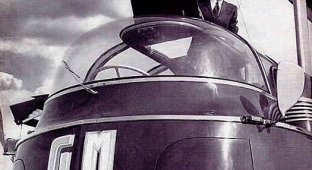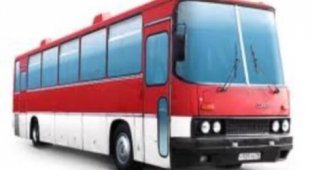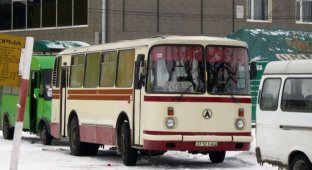Buses from the USSR - serial and experimental (16 photos)
Even the most avid motorist has traveled by bus at least once. Well, people of the older generation one way or another came out of Soviet LIAZs, LAZs and PAZs. In the territory of the former USSR, buses were made and assembled by more than 120 (!) factories. But we will remember only a dozen and a half cars: from serial, mass-produced ones to unusual and rare ones.

ZIS-8A
ZIS-8A is a product of the Leningrad ATUL plant on an extended ZIS-8 chassis. Cars with a capacity of 48 people (32 passengers rode sitting) were made with a third non-driving so-called rolling axle and a 73-horsepower ZIS-5 engine from 1936 to 1941. After the war, similar buses were produced, but with a carriage body.

YaA-2
YA-2 was unofficially called Gigant. In 1932, the auto repair shops of the Lensovet Motor Transport Administration (ATUL) built a three-axle bus with a length of 11.5 m, designed for 80 passengers (50 seats!) on a Yaroslavl chassis. The car had a 6-cylinder 7-liter American Hercules engine with 103 hp. (there was simply no suitable domestic one) and a four-speed gearbox with reduction gear. The brakes were mechanical, on the wheels of the rear trolley - with a vacuum booster. They made only one complex, expensive and clumsy machine.

ZIS-154
ZIS-154 is an amazing large city car that appeared immediately after the war, in 1946. The carriage-type bus was equipped with an American GM diesel engine - a two-stroke 4-cylinder with a power of 110 hp. Then they began to install a Soviet copy - YAZ-204. Transmission - electric automatic. The city car consumed up to 65 liters of fuel per 100 km, was very smoky and difficult to manufacture. Until 1950, only 1165 ZIS-154 were made, it was replaced by the simpler ZIS-155 with a gasoline engine in the front.

GZA-651
GZA-651, aka PAZ-561, aka KaVZ, RAF, KAG, etc. The now famous cars for short country routes or official needs, starting from 1950, for a quarter of a century, were produced by a dozen and a half factories in all parts of the vast country. The chassis, “face” and 70-horsepower 6-cylinder engine are GAZ, the bodies were made on a wooden frame for quite a long time, sheathing it with steel sheets.

PAZ-652
PAZ-652 is the first coach-built bus from the Pavlovsk plant. A prototype, based on the developments of the Gorky plant, was assembled in 1955. The body had a power frame - the car did not have a frame in the literal sense. Buses at GAZ units with a 90-horsepower 3.5-liter engine began to be produced in 1958, in 1963 the model was modernized, and since 1967 the PAZ-672 was made with a 115-horsepower V8 engine. More than 62,000 “Pazikov” model 652 were produced.

LAZ-695
LAZ-695 is one of the most popular city buses in the Soviet Union. The prototype, developed under the leadership of V.V. Osepchugova, appeared in 1956. The first industrial batch was made in 1957. The bus with a capacity of 55 people (22 seats) was made under the great influence of the best German designs. The body has a load-bearing base that acts as a frame, the suspension is on longitudinal springs with correction springs, which ensure excellent smoothness. The rear-mounted ZIL engine with a displacement of 5.6 liters developed 109 hp. Since 1961, the LAZ-695 and all subsequent versions were equipped with the Zilov V8. While modernizing, the LAZ-695 was made until 2003, and more than 268 thousand vehicles were produced.

NAMI-0159
Double-decker buses are not uncommon in the world. But in the Soviet NAMI-0159 the driver sat on the second floor! The 6x2 car with a V8 engine and automatic transmission was not planned for mass production, but was made to test bold engineering ideas. Cabin capacity has increased by almost 30%. What it was like for the driver up there, history is silent.

ZIS-5
Open resort buses on the ZIS-5 chassis for health resorts in the Crimea and the Caucasus were produced by several small factories on imported and domestic AMO and ZIS chassis. In particular, they were made by a Tbilisi enterprise under the tricky name of Zakavtopromtorg. After the war, similar vehicles were built on Gorky chassis, and open buses were made until the second half of the 1960s.

LiAZ-5E676
The first Soviet articulated bus LiAZ-5E676 was made in 1962. The 15.5 m long vehicle was built on the basis of the mass-produced LiAZ-158. Serial engine of 150 hp. was too weak for such a large bus. This is also why the articulated LiAZ remained a prototype. And later in the USSR Ikarus, similar in design, worked.

LAZ-699
LAZ-699 is the largest and most comfortable serial tourist bus in the USSR. The first version, 10,565 mm long, under the name Karpaty, was produced from 1964 to 1966. The ZIL-375 V8 engine, with a displacement of 7 liters, developed 180 hp. The heavy vehicle was placed on MAZ axles with spring-pneumatic suspension. There were 41 comfortable seats in the cabin. Tourist LAZs were produced in various versions until 2004. They made about 36,000 cars. In the photo - LAZ-699N (1972-1978)

PAZ-Tourist
PAZ-Tourist, 1969 - a prototype was made for the international bus competition in Nice, where Pavlov’s car was highly rated. The design was created under the leadership of S.I. Zhbannikova, design - M.V. Demidovtsev, who later worked at VAZ. The car was rear-engine, with a 150-horsepower ZIL-130 engine, had curved side windows, a wardrobe and a spacious trunk. A slightly modified version was planned for the series, and a simplified version was also made. But the plant was unable to begin mass production.

PAZ-3201
The all-wheel drive PAZ-3201 is a rather rare phenomenon in the world of buses. The car, a prototype of which was made in 1966, is based on GAZ-66 units. The eight-cylinder ZMZ engine with a volume of 4.25 liters developed 115 hp, the gearbox was four-speed with a two-speed transfer case. Serial production began in 1972. Until 1988, when the next model PAZ-3206 went into production, 13,873 all-wheel drive PAZ-3201 were produced. In the USSR, all-wheel drive "grooves", used mainly as departmental ones, were in great short supply.

RAF-2203
The smallest Soviet bus, RAF-2203, is a descendant of the 977 model. To produce a car with an original body unusual for the late 1960s, a new plant was built in Jelgava. The twelve-seater car was based on the clearly weak parts of the Volga. The engine developed 95 hp, the gearbox was four-speed, the brakes were drums with two hydraulic vacuum boosters. Since 1982, they have been making the modernized RAF-22038-02. The production of Rafiks was finally stopped in 1997.

LiAZ-677
LiAZ-677 and 677m are the most popular large city buses in the USSR. NAMI's development was progressive: suspension on air springs, a two-speed automatic transmission with torque converter locking. For the first time, the driver of a city car had the opportunity not to operate the gearbox lever all day. But the engine on the LiAZ was still the same - a voracious petrol Zilov V8 with a power of 180 hp. There were only 25 seats, the stated capacity of the bus was 80, and then 110 people. Who was counting them during rush hour? Witty drivers called the ever-crowded LiAZ trucks cattle trucks. In Likino, the 677th was made until 1996, at several factories from vehicle kits near Moscow until the end of the 1990s. In total, more than 194 thousand cars were produced.

Alterna
The child of perestroika is a bus of the Alterna brand near Moscow, which was created by an enterprise organized on the basis of the LiAZ Scientific and Technical Center. The car was designed as the cheapest possible, which can be equipped with serial ZIL or KAMAZ engines. In addition to Alterna-4216, they created articulated, intercity and airfield variants. In the Moscow region, production was carried out from 1993 to 1995. Alternas were also produced in Perm and Orsk.

























